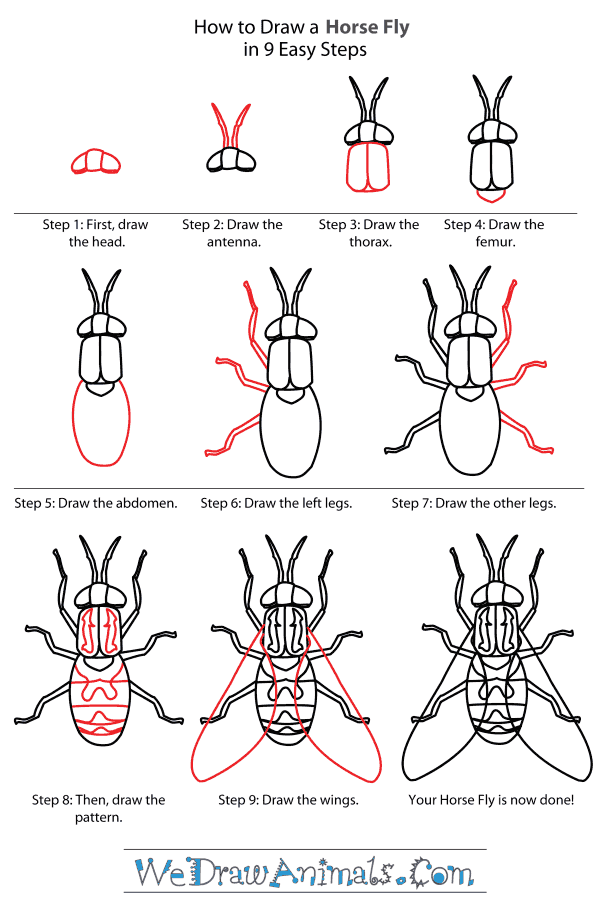In this quick tutorial you'll learn how to draw a Horse Fly in 9 easy steps - great for kids and novice artists.
The images above represent how your finished drawing is going to look and the steps involved.
Below are the individual steps - you can click on each one for a High Resolution printable PDF version.
At the bottom you can read some interesting facts about the Horse Fly.
Make sure you also check out any of the hundreds of drawing tutorials grouped by category.
How to Draw a Horse Fly - Step-by-Step Tutorial
Step 1: The first step in drawing your Horse Fly is to create the head. Start with a square shape in the middle and add a rounded shape to each side.
Step 2: Next you will need to add the antennae by drawing two long, jagged curving lines coming out of the top of the head.
Step 3: Now you will want to draw the thorax. To draw this, draw to elongated oval shapes and connect them with a line at the bottom.
Step 4: Next draw the femur by drawing a small bump on the bottom of the thorax,
Step 5: The next step is to draw the abdomen. To create the abdomen, draw a large oval coming off the bottom of the body.
Step 6: Now you will need to draw the left legs. Using angled lines, create three thin legs along the left side of the body.
Step 7: Next draw three legs on the right side of the body the same as you did on the left.
Step 8: The next step is to draw the pattern on the body. Create the pattern as shown above using a variety of straight and curved lines.
Step 9: For the final step, you will need to add the Horse Fly's wings. To do this draw a angled line coming from the top of the thorax to the bottom of the body. Connect it back to the top using a curved line. Repeat for the opposite side. You have now completed your Horse Fly.
Interesting Facts about the HORSE-FLY
The Horse-Fly is a member of the insect family and the scientific term for them is Chrysops relictus. Other common names for this animal are the Twin-Lobed Deerfly and European Fly. A stoutly-built bug, has patterning that may vary slightly but there is always black lobes on the second abdominal area. There are other related species and care needs to be taken when identifying them. The preferred habitat is in damp floodplain meadows. Other moist areas will work well also, especially when they are the most active in May to September, after the larvae have matured into flying.
Did you know?
- This species can be found on wet heaths and moors.
- The animal was first documented in 1820.
- They are found in woodlands.
- The animal is almost .5 inches long.
- These thrive in mud or soft wet ground.
This large insect has larvae which feed upon organic matter in watery soils, and are therefore termed hydrobionts, because they inhabit areas of high water content. Adults can give humans a painful bite, and the females suck the blood of slow animals. Males also feed on flower pollen, and they are fairly frequent and common in Britain.










